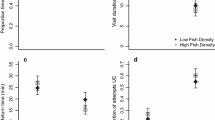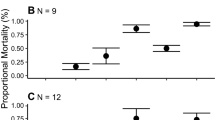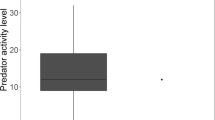Abstract
Capture success of many predator species has been shown to decrease with increasing prey group size and it is therefore suggested that predators should choose to attack stragglers and/or small groups. Predator choice in the laboratory has shown mixed results with some species preferentially attacking large groups and others preferring to attack stragglers over groups. Such predator choices have not been tested in the field. In our study we presented a binary choice between a shoal of guppies and a single guppy to predators in pools in the Arima river, Trinidad. We observed attacks in 11 different pools from a total of 53 predators (20 acara cichlids, Aequidens pulcher, 32 pike cichlids, Crenicichla frenata, and one wolf-fish, Hoplias malabaricus) and found that all predators showed a strong preference for the shoal of guppies in terms of both first choice and total number of attacks. We discuss the implications of these preferences with regards to predator–prey interactions.


Similar content being viewed by others
References
Cresswell W, Quinn JL (2004) Faced with a choice, sparrow hawks more often attack the more vulnerable prey group. Oikos 104:71–76
Croft DP, Arrowsmith BJ, Bielby J, Skinner K, White E, Couzin ID, Magurran AE, Ramnarine I, Krause J (2003) Mechanisms underlying shoal composition in the Trinidadian guppy, Poecilia reticulata. Oikos 100:429–438
Eklov P (1992) Group foraging versus solitary foraging efficiency in piscivorous predators—the perch, perca-fluviatilis, and pike, Esox-Lucius, patterns. Anim Behav 44:313–326
Endler JA (1986) A preliminary report of the distribution and abundance of fishes and crustaceans of the northern range mountains, Trinidad (unpublished)
Hoare D, Ruxton G, Godin J-G, Krause J (2000) The social organization of free-ranging fish shoals. Oikos 89:546–554
Krause J, Godin JGJ (1995) Predator preferences for attacking particular prey group sizes—consequences for predator hunting success and prey predation risk. Anim Behav 50:465–473
Krause J, Godin JGJ (1996) Influence of prey foraging posture on flight behavior and predation risk: predators take advantage of unwary prey. Behav Ecol 7:264–271
Krause J, Ruxton GD (2002) Living in groups. Oxford University Press, Oxford
Krause J, Ruxton GD, Rubenstein D (1998) Is there always an influence of shoal size on predator hunting success? J Fish Biol 52:494–501
Landeau L, Terborgh J (1986) Oddity and the ‘confusion effect’ in predation. Anim Behav 34:1372–1380
Lima SL (2002) Putting predators back into behavioral predator–prey interactions. Trends Ecol Evol 17:70–75
Major P (1978) Predator–prey interactions in two schooling fishes, Caranx ignobilis and Stolephorus purpureus. Anim Behav 26:760–777
Milinski M (1977a) Do all members of a swarm suffer the same predation? Z Tierpsychol 45:373–388
Milinski M (1977b) Experiments on the selection by predators against spatial oddity of their prey. Z Tierpsychol 43:311–325
Morgan J, Godin J-G (1985) Antipredator benefits of schooling behaviour in a cyprinodontid fish, the banded killifish (Fundulus diaphanus). Z Tierpsychol 70:236–246
Neill SR, Cullen JM (1974) Experiments on whether schooling by their prey affects the hunting behaviour of cephalopods and fish predators. J Zool, Lond 172:549–569
Pitcher T, Parrish J (1993) Functions of shoaling behaviour in teleosts. In: Pitcher T (ed) Behaviour of teleost fishes. Chapman and Hall, London, pp 363–439
Pritchard VL, Lawrence J, Butlin RK, Krause J (2001) Shoal choice in zebrafish, Danio rerio: the influence of shoal size and activity. Anim Behav 62:1085–1088
Scheel D (1993) Profitability, encounter rates, and prey choice of African lions. Behav Ecol 4:90–97
Schradin C (2000) Confusion effect in a reptilian and a primate predator. Ethology 106:691–700
Sih A, Moore RD (1990) Interacting effects of predator and prey behaviour in determining diets. In: Hughes RN (ed) Behavioural mechanisms of food selection. Springer-Verlag, Berlin, pp 771–797
Acknowledgements
We would like to thank Catherine Hathaway for help handling the data and Ronnie Hernandez for his general hospitality and help with equipment and facilities during our field season at Simla Research Station, Trinidad. We would also like to thank the editor, Ashley Ward, Charlotte Hemelrijk and an anonymous referee for their valuable comments on the manuscript. All experiments complied with the current laws of Trinidad and Tobago. M.B. was funded by a University of Leeds Scholarship
Author information
Authors and Affiliations
Corresponding author
Additional information
Communicated by C. St. Mary
Rights and permissions
About this article
Cite this article
Botham, M.S., Kerfoot, C.J., Louca, V. et al. Predator choice in the field; grouping guppies, Poecilia reticulata, receive more attacks. Behav Ecol Sociobiol 59, 181–184 (2005). https://doi.org/10.1007/s00265-005-0018-7
Received:
Revised:
Accepted:
Published:
Issue Date:
DOI: https://doi.org/10.1007/s00265-005-0018-7




